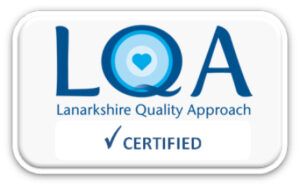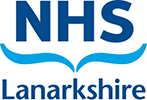Tongue Tie
Information for patients
NHS Lanarkshire Maternity Department
PIL.TONTIE.21_00004.L
For support with breastfeeding call:
Infant Feeding Team – 01698366710
For out of hours urgent feeding issues, call:
01698361100, extension 139
Why have I been referred to the breastfeeding clinic?
You will have been referred to the clinic following a feeding assessment by your health professional- midwife or Health Visitor because you are having ongoing feeding problems not resolved by adjustment to position and attachment, and because we suspect a structural issue such as tongue tie might be affecting your baby’s feeding. Part of the clinic process is that you will have a home visit from the infant feeding team to assist with feeding and to try to prevent the need for a surgical intervention. It is essential to maintain milk supply and optimise positioning and attachment before and following the procedure to increase chances of success.
If a baby is feeding normally the procedure would not be indicated and you will not be appointed.
What is Tongue Tie?
A tongue tie is the common name for the piece of tissue (Frenulum) joining the underneath of the tongue to the floor of the mouth, problems can arise when this tissue is too short or tighter than usual. This can sometimes restrict the movement of the tongue and interfere with the tongue movements required to feed effectively however most babies with tongue tie can feed effectively with good support.
Why divide a Tongue Tie?
In some babies with tongue tie their ability to attach at the breast is poor and does not improve despite help with positioning and attachment. Division of the tongue tie will not resolve feeding issues on its own, it is important that you have support to improve position and attachment both before and following the procedure.
How do we divide Tongue Ties?
Dividing the tongue tie is a very simple and quick procedure known as Frenotomy. The baby does not require an anaesthetic. We wrap them up in a blanket, snip the tongue tie with sterile scissors and give them back to you so you can feed them straight away.
Does it hurt?
It is difficult to know if dividing the tongue tie hurts. Some babies will sleep throughout, many do not liked being wrapped up and will be crying before the tongue tie is divided. Babies settle very quickly with a cuddle and feed following the procedure.
Are there risks of carrying out the procedure? All surgical procedures have an element of risk, the risks associated with this procedure are listed here:
- Bleeding: Slight bleeding is normal, feeding your baby is the best way of stopping this and staff will ensure bleeding has stopped before you leave the clinic. It is important your baby has had Vit K at birth and there is no family history of clotting disorders to prevent excessive bleeding (see over for important information following the procedure).
- Infection: There will be a small diamond shaped wound under the tongue; the inside of the mouth heals much faster than other areas of the body. You may notice a white or yellow patch under the tongue after a day or so, this is a normal part of the healing process. Infection is rare, but avoid putting fingers or anything unsterilised into your baby’s mouth for a few days. If you notice the wound appearing green or inflamed ask your GP to review.
- Damage/Scar tissue: With all surgical procedures there is a small risk of damage to surrounding tissue, in this case to other parts of the baby’s mouth, this is extremely unlikely and rare. Occasionally scar tissue may form as the wound heals which can also affect feeding.
- No Improvement: In at least 20% of cases there will be no noticeable improvement in feeding. If a baby has never attached to the breast this can be more difficult to resolve. It is essential to maintain milk supply and optimise positioning and attachment before and following the procedure to increase chances of success. Some mothers notice an improvement straight away but most notice a gradual improvement over the next few days but it can take longer for feeding to improve.
- Tongue-tie and speech: The purpose of this clinic is only to resolve breastfeeding issues, currently there is no conclusive evidence that babies with tongue tie are more likely to have speech problems, If there are any concerns at a later date your health visitor can refer you to speech and language therapy.
Following procedure
There have been rarely reported cases of bleeding which has occurred sometime after tongue-tie division, usually on the same day, when the babies have returned home. If this occurs the bleeding is usually very light and is triggered by strenuous crying resulting in the tongue lifting and disturbing the wound or when the wound is disturbed during feeding, particularly if the wound is caught by a bottle teat or tip of a nipple shield.
1. If you notice any blood in your baby’s mouth then offer the baby the breast or bottle and feed them. This will usually stop the bleeding within a few minutes just as it did immediately after the procedure. If the baby refuses to feed then sucking on a dummy/pacifier or your clean finger will have a similar effect.
2. If the bleeding is very heavy or does not reduce with feeding and stop within 15 minutes then apply pressure to the wound under the tongue with one finger using a clean piece of gauze or muslin for 5 minutes. Do not apply pressure under the baby’s chin as this can affect breathing.
3. If bleeding continues after this time continue to apply pressure to the wound and take your baby to hospital call an ambulance if you live more than a very short distance from the Accident and Emergency Department.
Before your appointment
After you have been referred to the clinic there are some things that you can do to maximise the chances of the procedure being successful. Frenotomy on its own will not improve feeding, it is important to continue to work on optimising position and attachment and milk supply. Please inform us if there are any changes to your circumstances, if you or your baby are ill or if your baby has oral thrush as we may need to delay the procedure until treated.
Maintain your supply
If your baby is receiving expressed breastmilk or formula milk for any reason then it is important that you express each time an additional feed is offered to maintain your supply. If the baby is not attaching at the breast then it is important to express at least 8-10 times in 24 hours. We can only perform the procedure on babies who are receiving mostly breastmilk. Continued skin to skin and keeping baby familiar with the breast is important.
Optimise position and attachment
Working on improving attachment before and after the procedure is a key factor in success.
In most mothers/babies “laid back” feeding will result in optimised attachment – remember CHIN principles.
C Close (no gap between baby’s body and mothers)
H Head free (no fingers near head)
I In a straight line (facing towards mother)
N Nose to nipple (to encourage baby to reach up) baby will come to breast with wide mouth CHIN first, chin will indent breast and effective suck swallow pattern will be evident.

Pub. date: February 2023
Review date: February 2025
Issue No: 03
Reference: PIL.TONTIE.21_00004.L
23_03487
If you need this information in another language or format, please e-mail:




